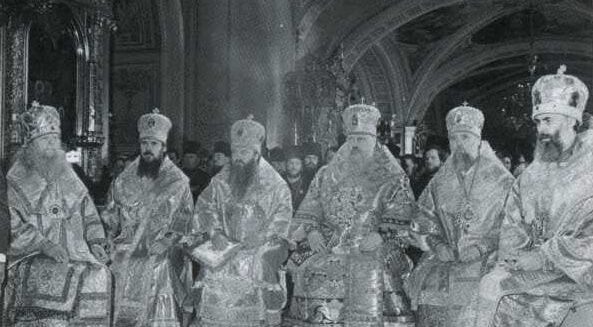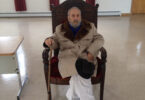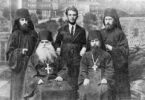With the death of Metropolitan Anastasii, a twenty-year period of relative tranquility drew to an end. This had nothing to do with the personalities of Anastasii or his successor, but was a development of the times — in particular, the impact of the Ecumenical Movement on Orthodox Churches throughout the world. However, before looking more closely at the influence of ecumenism, we must examine Metropolitan Philaret’s character and personality.
Whereas one could rightly describe Metropolitans Antonii and Anastasii as great prelates and true “Princes of the Church” in the positive sense, Metropolitan Philaret was, throughout his life, a humble and quiet monk. This is not to say that he was a “simple” man without personal gifts and depth, but rather that he valued his monastic calling before any other. In his view, he could be an effective first hierarch primarily by being a good monk. Thus, he lived in the splendid metropolitan’s suite in New York as if it were the simplest monastic cell. His only outside interests were fishing (which he was occasionally able to pursue at the peace of a hermitage in the New York countryside) and music (he was an accomplished pianist and composer).
Born Giorgii Voznesenskii in 1909 in the city of Kursk (the original home of the Kursk Icon, the “Directress” of the Church Abroad), he and his family fled to China in the early 1920s, where he received degrees in engineering and theology. In the 1930s, he was ordained and entered monastic life with the name of Philaret. The future Metropolitan was somehow able to remain in China under Mao until 1962, when he went with his flock to Australia. There, in 1963, he was consecrated bishop.
Small and frail of stature, there was about Philaret a quality of other-worldliness that enveloped all who came into contact with him. This, combined with an outspoken fidelity to the traditions of the Church, made him the object of some criticism. By the Orthodox Left he was regarded as a fanatic, and by the Orthodox Right he was considered weak or liberal. In reality, he was “like to the Holy Fathers of ancient times, who placed purity of Orthodoxy above all else.” [1] Orthodox Word, (January/February 1976).
All of which must be kept in mind while examining the challenging events of the 1960s and 1970s.
As far back as 1959, the Russian Church Outside Russia had been aware of ecumenical stirrings in the Roman Catholic Church. When, in January 1959, Pope John XXIII announced an ecumenical council to which observers from Orthodox Churches would be invited in order to discuss Church unity, Orthodox hierarchs from all over the world contemplated what their response should be. Accordingly, at the Sobor of 1959 the Church Abroad adopted a formal resolution “with regard to questions dealing with the Roman Catholic Ecumenical Council.”
The resolution began with a question: “What Christian heart does not grieve over the fact that Western Christians headed by Rome have been separated from us already for more than nine hundred years? And who would not rejoice if an end to this separation were to ensue?” But since the stated goal of the council, from the Pope’s viewpoint, was primarily the propagation of the Roman Catholic Faith, the Russian bishops concluded that “a common Sobor of Orthodox and Roman Catholics does not appear likely while the latter confesses the dogma of the infallibility of the Pope… [which] places the Pope above the Sobor… contrary to the ancient doctrine of the Church.” The bishops then called on the faithful “to firmly follow the ancient traditions of our Fathers, without yielding to the externally enticing (yet far removed from Orthodoxy) perspectives of unification…in which reigns the spirit of interconfessionalism, inescapably leading to indifference towards dogmatic truth.” [2] Orthodox Life, (January/February 1960).
Vatican Council II gave great impetus to what had otherwise been a sluggish Ecumenical Movement, the principles of which became clearer as the years went by. The basic “doctrine” of ecumenism was that the original Church of Christ had been shattered over the centuries by man-made divisions. Therefore, certain denominations were but “branches” of the Church, and no one group should claim the fullness of the Truth. Such an idea cannot be found in the teachings of the early Church Fathers, who always proclaimed not only the visible oneness and unity of Christ’s Body, but also that it was supernaturally protected from division.
Although fourteen observers from various other Orthodox Churches — including the Moscow Patriarchate — did attend sessions of Vatican II, the Church Abroad remained steadfast in its polite, yet firm, refusal to participate in any way. (Time proved their instincts to be correct; years later it was revealed that the Patriarch of Moscow sent representatives on the condition that the council would not issue any anti-Communist statements — a compromising agreement that would have repelled the exiled bishops.) Even so, there was no great alarm until December 7, 1965 when, unexpectedly, a simultaneous announcement was made by the Vatican and Patriarch Athenagoras of Constantinople to the effect that the mutual anathemas of the two Churches in the eleventh century were being lifted or “raised” as “a gesture of goodwill between the two Churches.” [3] Macris, George F., The Orthodox Church and the Ecumenical Movement During the Period 1920-1969, p. 77. On the Orthodox side, this was almost universally regarded as a “scandalous” violation of the good order of the Church, for, unlike the Pope, the Patriarch of Constantinople is not the “head” of the Orthodox Church and cannot act unilaterally. Since the anathema had been leveled against Rome by a Church Council, only another council of equal authority could remove it. Bishops from many jurisdictions now charged Patriarch Athénagoras with “caesaro-papism.”
Within a week of the announcement, Metropolitan Philaret appealed to the Patriarch of Constantinople “to put an end to his confusing acts since they would provoke schism in the Orthodox World.” [4] Ibid., p. 80. He added that it was not a question of goodwill towards Roman Catholics, but of serious doctrinal differences between the two Churches.
“No union of the Roman Church with us is possible until it renounces its new doctrines [papal infallibility, Immaculate Conception, indulgences, etc.], and no communion in prayer can be restored with it without a decision of all [italics added] churches… Certainly we are not opposed to benevolent relations with representatives of other confessions as long as the truth of Orthodoxy is not betrayed.” [5] Ibid., p. 81-82.
This was consistent with the earlier decision of the Synod Abroad not to join the World Council of Churches, even when other jurisdictions were doing so:
“The Russian Orthodox Church Outside Russia does not participate in the World Council of Churches [because it] attempts to represent those assembled in it — representatives of confessions differing in their opinions — as though they had some sort of unity in their faith… In addition, any sort of participation by Orthodox in prayer with non-Orthodox… is strictly forbidden for Orthodox according to the 45th and 46th canons of the Holy Apostles, and subjects them to ex-communication from the Church.” [6] Orthodox Life, (November/December 1983).
Metropolitan Philaret now composed a series of what have since been called “Sorrowful Epistles” to Patriarch Athénagoras, Archbishop Iakovos of the Greek Archdiocese of North and South America, and others, attempting to call them back to faithfulness to Orthodox tradition and good order. Dialogue with the heterodox, he explained, is impossible because “dialogue” implies equality, and since the Church of Rome had, in the eleventh century, departed from the fullness of the Truth, the two Churches are by no means equal. Instead of dialogue, he pointed out, there must be monologue:
“Church tradition and the example of the Holy Fathers teach us that no dialogue is conducted with Churches that have fallen away from Orthodoxy. To them is always directed the monologue of the Church’s preaching, in which the Church calls them to return to her bosom through rejection of every teaching not in accord with her.” [7] Orthodox Word, (January/March 1966).
Such words, however, had virtually no impact. Even those bishops who had originally protested the Patriarch’s action now began to participate in and encourage further “dialogue” and joint-prayer meetings with Rome (as well as with the Anglican and Lutheran Churches), prompting Archbishop Vitalii (Ustinov) of Montreal and Canada to make the following observation in 1969: “A tower of Babylon [is] in the making… Ecumenism is now at the very doors of our Church… It is time for us to bind all dogmas immediately to our soul… penetrated with prayer.” [8] Orthodox Word, (July/August 1969).
The challenge of ecumenism now raised the whole issue of ecclesiastical change and reform. Renovation and innovation were fashionable everywhere, not just in Roman Catholicism, but also in many Orthodox jurisdictions. More and more, as the years went by, the Russian Church Abroad took careful notice of increasing “reform-fever” the Orthodox world and, in 1978, a special epistle was issued:
“One must keep in mind that the Church is a theanthropic organism, whose Head is the Lord Jesus Christ and whose life is directed by the Holy Spirit. Thus, the Church is in no need of human reform, be they in the realm of her dogmatic teaching, in the amending of apostolic traditions, or the alteration of canon laws and liturgical practices hallowed by centuries of use. Those who wish to reform the Church do not understand that they themselves must turn as quickly as possible to the grace-bearing life of the Church which, as the Apostle says, is the pillar and ground of truth. Those who wish to renovate the Church, alas, do not desire their own personal renovation within her… It is not for us to bring the Church to perfection, but we ourselves who must be perfected within her through the grace of the Holy Spirit.” [9] Orthodox Life, (November/December 1978). [italics added]
In April 1970, Patriarch Aleksii of Moscow died at the age of ninety-two, just as negotiations between the Metropolia and the Patriarchate were drawing to a close. Probably Aleksii had had nothing to do with the negotiations anyway, for his successor said that, during the Patriarch’s last five years, the business of the Russian Church had essentially been run by Aleksii’s private secretary. Although the negotiations were coming to a successful conclusion, even with the patriarchal throne vacant, the bishops of the Church Abroad sent a declaration to the bishops of the Metropolia in October 1970:
“It is impossible for the Moscow Patriarchate, under the complete control of the Soviet atheistic regime which has set for itself the goal of destroying all religion, to do anything which could be to the overall benefit of the Church and it must be remembered that the Moscow Patriarchate cannot engage in foreign affairs without a direct order of the Soviet government… It is not our intention to inflict upon you any hurt, but rather to give you again a brotherly warning of the danger now threatening you… The Synod of Bishops [Abroad] has not forgotten that until very recently we and you were united in one Russian Orthodox Church Abroad… We grieved when this unity was disrupted… In your hearts, you must all know that the Moscow Patriarchate in its present form is not the true representative of the Russian Orthodox Church… Therefore we are addressing you all, Bishops, Pastors, and Laity, for the last time. Let all other considerations fall. Return back to the unity of the free [Church] before it is too late.” [10] Orthodox Life, (September/October 1970).
This appeal, as all the others since the Metropolia’s second schism in 1946, went unheeded, although over the next dozen years a few Metropolia parishes individually returned to the Church Abroad. (See Appendix VI for the entire text of the Church Abroad’s decree breaking communion with the Metropolia.)
In the late spring of 1971, Metropolitan Pimen (Izvekov) was elected patriarch of Moscow. Immediately, the exiled Russian Church adopted a resolution stating that “all of the elections of Patriarchs in Moscow, beginning in 1943, are invalid on the basis of the 30th Canon of the Holy Apostles and the 3rd Canon of the 7th Ecumenical Council, according to which, ‘if any bishop, having made use of secular rulers, should receive through them episcopal authority in the Church, let him be defrocked and excommunicated along with all those in communion with him.'” Since Sergii (elected 1943), Aleksii (1945), and Pimen (1971) were all “elected” at the pleasure and with the official approval of the Soviet government, these elections, the bishops in exile said, are to be “regarded as unlawful and void, and all of [their] acts and directions as having no strength.” [11] “Resolution of the Russian Orthodox Church Outside of Russia Concerning the Election of Pimen [Izvekov] as Patriarch of Moscow,” undated.
During the two decades of Metropolitan Philaret’s rule, the Russian Church Abroad had gradually come to a fuller understanding of her role in worldwide Orthodoxy. She thus began to define herself not just as the free part of the enslaved puppet-Church (the Moscow Patriarchate), but also as the standard bearer of faithful Orthodoxy, a Church treading the “royal path”:
“The “royal path” of true Orthodoxy today is a mean that lies between the extremes of ecumenism and reformism on the one side, and a “zeal not according to knowledge” (Rom. 10:2) on the other. True Orthodoxy does not go “in step with the times” on the one hand, nor does it make “strictness” or “correctness” or “canonicity” (good in themselves) an excuse for Pharisaic self-satisfaction, exclusivism, and distrust, on the other. This true Orthodox moderation is not to be confused with mere lukewarmness or indifference, or with any kind of compromise between political extremes.” [12] Orthodox Word, (September/October 1976).
However, the traditionalism of the Church Outside Russia was to cost her dearly, both in the eyes of other Orthodox jurisdictions and from within — for unknown to the Synod Abroad, she was unwittingly nurturing in her own bosom a very dangerous viper.
References
| ↵1 | Orthodox Word, (January/February 1976). |
|---|---|
| ↵2 | Orthodox Life, (January/February 1960). |
| ↵3 | Macris, George F., The Orthodox Church and the Ecumenical Movement During the Period 1920-1969, p. 77. |
| ↵4 | Ibid., p. 80. |
| ↵5 | Ibid., p. 81-82. |
| ↵6 | Orthodox Life, (November/December 1983). |
| ↵7 | Orthodox Word, (January/March 1966). |
| ↵8 | Orthodox Word, (July/August 1969). |
| ↵9 | Orthodox Life, (November/December 1978). |
| ↵10 | Orthodox Life, (September/October 1970). |
| ↵11 | “Resolution of the Russian Orthodox Church Outside of Russia Concerning the Election of Pimen [Izvekov] as Patriarch of Moscow,” undated. |
| ↵12 | Orthodox Word, (September/October 1976). |











